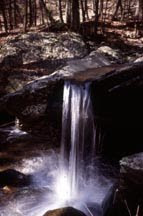A couple evenings back I took in some live music in a roadhouse not far from my home. A good friend of mine moonlights on mandolin with a four piece acoustic roots ensemble, and they’re good. An interesting side effect of their occasional performances in our area is the attendance of every left winger in this extremely conservative Pennsylvania county. The heads are often grey, but peasant skirts and tie dye are in evidence, the sweet smell of funny cigarettes is noticeable in the parking lot, and the political talk is pretty lefty, and sometimes pretty far out there. For example…
I was sitting at a small table with two friends, one of them the mandolin player’s wife who is an Emergency Room nurse, enjoying dinner and watching the band sound check, when we were joined by another old friend who’s been visiting from his home in New Hampshire. He’s my age (mid-50’s), a carpenter and general handyman. He’s wound up real tight, and pretty fringe, but he’s a really nice guy. Having recently completed the sad duty many folks my age are called on to perform, and nursed his mom through her final illness, he took some time and completed the Pacific Crest Trail. Now he’s starting to sniff the wind, and figure out what comes next. We talked about that.
“So what now?”
“I don’t know, but I’m really feeling like I maybe should think about simplifying even more than I have been, you know? I have no debt, no young kids. If I sell my place, then I have nothing tying me down, ya know. I can live in my van, and visit with folks, camp and hike, and work on a project when I need a little cash. Ya know, strip it down to just the important stuff.”
“Health insurance?”
“Well, ya know, I’m thinking I can do just fine without that. I mean, if you hold your income down low enough, they have to treat you for anything catastrophic, right?”
At this point, our friend the nurse agreed that below the poverty line patients get help from the hospital in applying for public assistance or the hospital just writes the treatment off. Wonderful. His hippy-ass isn’t paying for his trip to the emergency room. I am, and so are you, with higher health insurance costs. This country is full of people who develop opinions without a lot of facts or consideration for others. I am reminded of the tea-bagger I watched last year shrieking into the face of a legislator that she wanted “…the government to keep its goddamned hands off my Medicare!”
“Well, what about preventative care?”
“I don’t know, I mean I’m pretty fit and healthy. I did actually have a physical at a doctor’s office this year, but what a ripoff! I mean he just listened to my chest and asked me a few questions and he was outta there in less than 10 minutes!”
“Really?”
“Well, he did check my prostate, but ya know, it seemed like he was only in there for a second. I mean, what could he possibly learn from that? I don’t think he took enough time. Actually, I think I could probably check my own prostate with some instruction and do a better job than that!”
At this all ears at the table perked up.
“So how do you suppose you could do that man?”
“Well, there must be a way.” Turning to my friend across the table he said “You’re a nurse, couldn’t I just check it myself?”
He’s been staying at her place the last week or so, and she’s probably a little tired of him (as you’ve guessed by now, he’s a large personality), so she just chewed her pasta for awhile and looked at him. Then she said, “I don’t know man. You seem pretty determined though, so maybe.”
“Well, I mean how hard could it be? Women do self examinations of their breasts, right?”
In unison the rest of us at the table blurted out “It’s different than that.”
One of us observed that access might be difficult, but he was undeterred.
“Well, I wipe my backside each morning, how different could it be from that?”
Several of us again responded “It’s probably different from that too.”
We brought up the issues of professional experience, diagnosis and interpretation of results, and useful recommendations, but he went away undeterred. I assume that, as of this writing, he has probably made at least one attempt…maybe more. Good for him.
Believe it or not, I kind of understand. I spent 6 months living out of a backpack on the Appalachian Trail in 1981. The experience left me with the secure and rock-solid understanding of what is important and what is not important in this world. Clean water is important. A warm dry place to sleep is important. A healthy and fit body is important. Sufficient and wholesome food is important. The affection of other people is important. Everything else is not that big a deal. My thinking has of course evolved to allow for the significance of civic life, for my profession, for the appreciation of creature comforts and good books and music, but I haven’t forgotten. You can do without a lot, and still be happy in this world.
I’ve always treated this as the great epiphany that has guided my adult life, but maybe not. I am reminded of a conversation I had with an editor friend of mine the previous week in which he opined “Sometimes when you see a bright flash of light and hear a loud ‘pop’ it’s not an epiphany. Sometimes it’s just you pulling your head out of your own ass.”
.
























